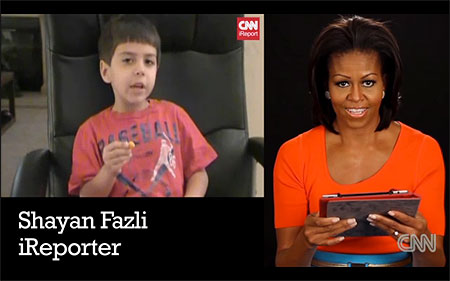
Scene from a fuel subsidy protest in Idaban, Nigeria. Image courtesy CNN iReport.
The conversation on the desk usually goes like this: "Wow. Did you see this iReport? Incredible."
"Yeah, no kidding. But how are we going to vet it?"
The answer in broad strokes: It's an emerging craft, one that combines an eye for a good story with a flair for connecting the dots and, above all, a human touch.
Vetting is the heart of iReport, CNN's platform for citizen journalism. You won't see iReports on television or on CNN.com (outside the special iReport section, that is) before they've been fact checked and cleared.
The vetting process is rigorous and sometimes time-consuming. It usually starts with a phone call, most often from the iReport desk in Atlanta, where eight full-time producers tab through hundreds of incoming photos and videos every day, looking for the ones we think will make an impact.
About 8 percent of contributions are selected for vetting, a process that also alerts TV and digital producers there will likely be an element ready to go later in the day. Vetted iReports often turn into interview segments on air or quotes in stories you read online.
One morning in January, for example, iReport producer Christina Zdanowicz hit the desk to find scores of new photos and videos showing protests over increased fuel prices in Nigeria. Often when similar stories pile up on iReport, they're connected to a news event CNN is already on top of, like a natural disaster or a big political rally. The Nigerian iReports took us a bit by surprise—CNN was not yet reporting this so iReport was asked to sketch out the story.
Verifying Reports
One important contribution was a video showing a protest in the streets of Ibadan, Nigeria, earlier that morning. To investigate the authenticity of the clip, Zdanowicz reached out to the Ibadan iReporter, a 24-year-old pharmacist named Boma Tai. He described when and where and why the protest was happening and who was participating.
All good and useful detail, but there was a catch: He wasn't just observing, he was participating, and he shared footage of the event because he wanted "the world to know in raw and unedited terms what is going on in Nigeria … the poor are suffering!" So we decided to see what other context we could find to fill out the story.
Most of the video we see of protests and similar news events is like the Ibadan clip: it comes from someone in the heart of the story, with a very subjective view of events. No surprise, of course, because iReport and most social media platforms are built for sharing the moments of your life.
At CNN we see it as our responsibility to add context and analysis to what we use from iReport and other social media platforms. That's why with the Nigeria protest, the iReport team continued to make calls all morning to iReport contributors who'd seen similar protests in Lagos and Abuja and Benin City.
Then we worked with a reporter at CNN International who connected the details we'd researched with comments from the local police, the office of President Goodluck Jonathan, and the economic and historic context of fuel price subsidies in Nigeria. Together, the citizen journalism, our research, and the reporter's contributions formed a comprehensive story that provided images and video of the protests as well as news analysis explaining the context and why this was happening.
In a number of ways, the Nigerian protest story is a simple example. After talking to dozens of people about the same events, it wasn't a huge leap to say that we believed they had happened, even though CNN didn't have a reporter on the ground to witness them.
The challenge was different when a teenage girl posted a video on iReport showing her being bullied. We verified it the old-fashioned way—by talking with her family and school officials and tracking down police reports.
And when a South Carolina woman started posting biting—and popular—webcam commentaries about the 2012 Republican presidential primary race, the vetting process wasn't so much about getting inside her head and verifying whether she really thinks the things she said. It was more about figuring out who she is and how she got to the point of posting videos of her commentary and saying that plainly and clearly to our audience.
At iReport we use a variety of tools: CNN-ers in the field, subject-matter experts, affiliate networks, and local media. We cross-check what we learn from citizen journalists with other social media reports.
We also use technology, which can't prove if a story is reliable but offers helpful clues. For example, we often check photo metadata to find timestamps and sometimes location data about the source photo or ask a photographer to share the previous or next 10 images from her camera. We also occasionally send an image through a service like TinEye to help determine whether it shows signs of alteration.
That's the journalism part—figuring out what you need to add to a video or photo that you find on the Internet to make sense of it and to help someone else understand why it matters.
Building Community
But there is also the community part: Vetted iReports are a giant Rolodex of stories and people to follow up on. This March when the world marked the first anniversary of the earthquake and tsunami in Japan, CNN asked the iReporters who had shared footage of that event for updates on how they were faring. The result is as tender a portrait as you'll read in an anniversary piece.
More than offering immediate firsthand glimpses of breaking news, the community we are building may be the real secret behind iReport's success. Our platform provides an open door to participating in the news to almost anyone who cares to enter, and a growing number of people from all over the world are doing just that; as of May 2012, there were more than one million registered iReporters.

CNN’s iReport invited viewers to submit questions for first lady Michelle Obama.
Outside of vetting, the iReport team in Atlanta spends the majority of its time dreaming up ways to invite that community—both existing and future members—to take part in what CNN is doing. For example, we've come up with new models, such as a recent community-driven interview with first lady Michelle Obama or a mash-up video of footage shot by people in various cities and countries on a single day in March.
We discovered early on that it wasn't enough to wait for news to break and hope people might think to contribute (and set off the vetting process). iReport today is a highly collaborative effort among professional journalists, eyewitnesses and passionate participants to tell the full breadth of news stories as they unfold and to reinvent the process together as we go.
Lila King is participation director for CNN Digital, where her work is focused on inviting CNN's global audiences to participate in the news.



